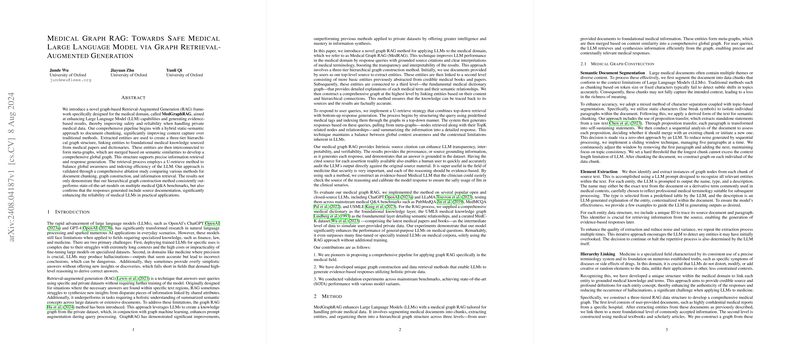Medical Graph RAG: An Innovative Approach to Medical LLMs via Graph Retrieval-Augmented Generation
The paper "Medical Graph RAG: Towards Safe Medical LLM via Graph Retrieval-Augmented Generation" presents a novel framework aimed at enhancing LLMs within the medical domain. Authored by Junde Wu, Jiayuan Zhu, and Yunli Qi from the University of Oxford, the work introduces MedGraphRAG, an advanced graph-based Retrieval-Augmented Generation (RAG) system. This paper outlines significant improvements in generating evidence-based results, thereby improving the safety and reliability of LLMs when handling sensitive medical data.
Introduction
The advent of LLMs such as OpenAI’s ChatGPT and GPT-4 has revolutionized natural language processing, contributing across various fields. However, these models face specific challenges in domains requiring precise knowledge, such as medicine. The main challenges are LLMs' difficulty handling extensive contexts and the risk of producing inaccurate outputs or hallucinations. These factors necessitate the development of specialized methods to enhance their applicability and reliability in critical fields like medicine.
Methodology
The authors propose MedGraphRAG, an innovative graph RAG framework tailored for medical applications. This method comprises several meticulous steps designed to improve information retrieval and response generation. The pipeline involves:
- Semantic Document Segmentation: The document segmentation process employs a hybrid static-semantic approach. It first partitions the document using character separation and then semantically analyzes each segment to ensure that context subtleties are captured, thereby preserving the meaning throughout the chunked segments.
- Entity Extraction: Using LLM prompts, entities within each chunk are identified and categorized. This iterative process ensures comprehensive extraction, maintaining a unique ID for each entity to facilitate traceability and source referencing.
- Hierarchy Linking: The extracted entities are integrated into a three-tier hierarchical graph. The top tier includes user-provided documents, the middle tier incorporates medical textbooks and scholarly articles, and the bottom tier consists of a medical dictionary graph. This hierarchical structure ensures that each entity is grounded in authoritative medical knowledge, enhancing response accuracy.
- Graph Construction and Meta-graph Formation: Relationships between entities are identified, and a weighted directed graph is constructed within each data chunk. These meta-graphs are subsequently merged based on semantic similarities to formulate a comprehensive global graph.
- Information Retrieval (U-retrieve Method): For query responses, the system employs a U-retrieve strategy, balancing top-down retrieval with bottom-up response generation. This method ensures that responses are not only relevant but also contextually informative, encompassing both global awareness and detailed contextual limitations.
Experimental Evaluation
The evaluation was conducted using several LLM variants, including LLAMA2, LLAMA3, GPT-4, and Google’s Gemini, across standard medical QA benchmarks such as PubMedQA, MedMCQA, and USMLE. The results are notable:
- Performance Improvement: MedGraphRAG significantly enhances model performance in medical QA tasks, particularly on smaller LLMs. It also enables larger models, such as GPT-4, to achieve state-of-the-art (SOTA) results, even surpassing human expert performance on certain benchmarks.
- Evidence-based Response: The framework’s ability to generate responses grounded in source documentation improves transparency and reliability, essential factors in medical applications. The comparison between GPT-4 with and without MedGraphRAG illustrates the framework’s efficacy in producing accurate, evidence-backed diagnostics.
- Ablation Study: Comprehensive ablation studies validate the methodology, demonstrating that each component—hybrid document chunking, hierarchical graph construction, and the U-retrieve method—contributes significantly to the overall system performance.
Implications and Future Directions
The practical implications of MedGraphRAG are substantial, particularly in clinical scenarios where the accuracy and reliability of information can directly impact patient outcomes. The hierarchical graph structure not only augments the LLM’s ability to retrieve and synthesize relevant information but also minimizes the risk of hallucinations by ensuring that responses are evidence-based.
Theoretically, this work pushes the boundaries of RAG methods, demonstrating the potential for hierarchical graph structures to support more sophisticated information retrieval systems in specialized domains. Future research could explore the application of MedGraphRAG in real-time clinical settings, its scalability across diverse datasets, and further optimizations in graph construction and retrieval strategies.
Conclusion
In summary, the paper "Medical Graph RAG: Towards Safe Medical LLM via Graph Retrieval-Augmented Generation" provides a significant contribution to enhancing the capabilities of LLMs for medical applications. By leveraging a hierarchical graph structure and advanced retrieval methods, the authors present a robust framework that not only improves the performance of LLMs in specialized QA tasks but also ensures that outputs are reliable and backed by credible sources. This paper lays the groundwork for future research and practical implementations of graph-based RAG frameworks in critical domains like medicine.
